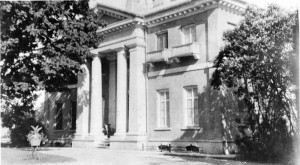Street Address : 146 Stuart St.
Period : After 1950
In the past, the equation of homosexuality with mental illness was a common misconception among gays and straights alike. In the late 1800s and early 1900s, sexologists such as Havelock Ellis began to comment on the sexual potential of relationships between women that previously had fallen under the category of “romantic friendships” These notions of the homosexual as invert categorized lesbians and gay men into a third sex, defined by a combination of sexual desire for someone of the same sex and transgressive displays of masculinity in women or effeminacy in men. By declaring homosexuality biologically determined and thereby incurable, this medical construction did free some “inverts” from the notion that they were responsible for their “condition”. However, it still placed same-sex desire firmly in the realm of deviant behaviour.
By the post-World War II era, constructions of homosexuals as inverts had metamorphosed a number of times in response to changing socio-economic conditions. The notion that lesbians and gay men were mentally ill individuals who needed psychiatric care arose at this time and persisted well into the early years of gay liberation. “Treatments” for homosexuality varied, and sometimes included such extreme tactics as electro-shock therapy. George, a gay Kingston man who worked at a psychiatric institute in the 1960s in another small southern Ontario city, remembers administering electric shock treatments to butch women placed in hospital. “We had a very good superior who’d say, ‘for Christ’s sake put on high heels and a dress and walk out the door.’ but some of them couldn’t and they [the doctors] were banging and banging at them to try to knock it out of their heads.”
While some gays were forced into psychiatric care, other sought “help” willingly. Maureen, who came to Queen’s in 1969, describes looking up homosexuality in the medical library and finding it to be classified as a mental illness by the American Psychiatric Association. Maureen describes her experience:
“I went to student health because I had decided to become heterosexual since clearly it was a mental illness and I could get it worked on and being an outsider wasn’t all that nice. So I actually was assigned a woman psychiatrist who thought I was a bit of a freak I think. She turned out to be a grad student in psychiatry who referred me to, I guess it must have been the attending psychiatrist, and I started seeing him but he would only see me on the understanding that our sessions would be recorded and taped and that there was a two-way glass mirror behind which were grad students and it was very difficult in those days to get on a waiting list and to get seen by a psychiatrist so for me it wasn’t really something I could bargain. It was, this is the way it’s going to be or you go back on the waiting list, so I had some fairly painful sessions [during] some of which there was this big burly guy with a beard in the room with a video camera, um, and I knew that the students were behind the glass and it was really hard for me to talk about being a lesbian and, um, open up in those circumstances it was really difficult. And of course he was challenging whether I was a lesbian. ‘Well, what makes you think you are a lesbian?’, ‘Well, I’m constantly falling in love with other women.’ ‘Well, have you ever slept with a woman?’ ‘Well, no.’ ‘Oh, so what wrong with you is you just need to sleep with some men, all you need is a good —-‘ um, so for a while I did do that. I went to the Queen’s Pub and picked up men, clearly that wasn’t what I needed so I stopped going to that particular shrink and got another one and by that point had fallen in love with a woman in my residence which was Chown Hall and, um, gave up on the psychiatrist and gave up on the idea of switching to heterosexual since clearly after I had slept with a woman I understood that that was really was what I wanted to do [laughs] so it was pointless to go on. So that all came out of reading that it was a mental illness and trying to fix what was wrong with me. “
Only with intense pressure from gay activists did the American Psychiatric Association, in 1973, repeal its classification of homosexuality as a mental disorder. Statistics Canada’s Manual for the Classification of Psychiatric Diagnoses continued to define homosexuality as a mental disorder into the late 1970s.


